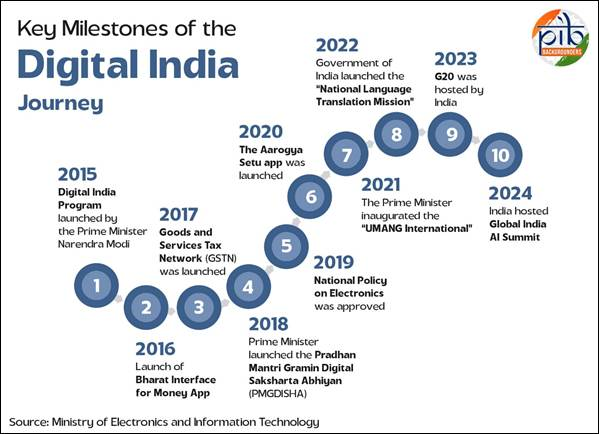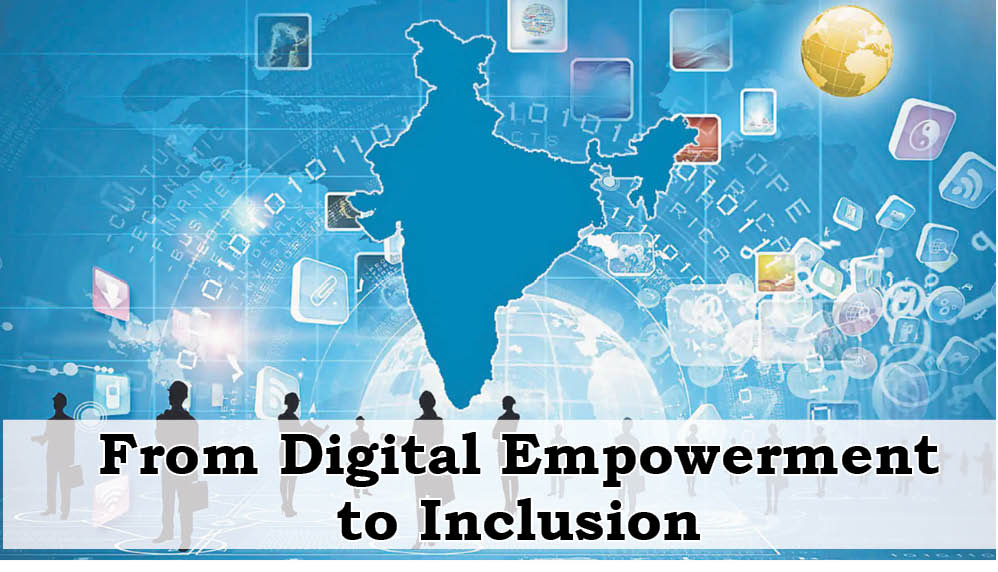Context-
Launched on July 1, 2015, the Digital India programme has completed ten years in 2025. What began as a government-led initiative has now evolved into a broad-based transformation that touches nearly every aspect of life in India—from public service delivery and financial inclusion to education, healthcare, commerce, and agriculture.
Prime Minister Narendra Modi described Digital India as a “people’s movement” that has empowered 140 crore Indians and placed India among global digital leaders. From limited internet access and low digital literacy in 2014, India has seen a massive leap in digital infrastructure, platforms, and services. This shift has significantly impacted governance, social inclusion, and economic development.
Vision and Structure of Digital India:
The Digital India Mission was launched with the vision of transforming India into a digitally empowered society and knowledge economy. It is structured around nine pillars, each addressing a key area of digital transformation:
1. Broadband Highways
2. Universal Access to Mobile Connectivity
3. Public Internet Access Programme
4. e-Governance: Reforming Government through Technology
5. e-Kranti: Electronic Delivery of Services
6. Information for All
7. Electronics Manufacturing
8. IT for Jobs
9. Early Harvest Programmes
These pillars are interlinked and aim to deliver inclusive growth across infrastructure, services, and citizen empowerment.
Major Achievements Over the Decade:
Internet Connectivity
- Internet connections increased from 25 crore in 2014 to over 97 crore in 2025.
- Around 6.92 lakh km of optical fibre has been laid under the BharatNet project, covering over 2.18 lakh Gram Panchayats.
- India’s 5G rollout has been one of the fastest globally, extending even to forward military areas like Galwan and Siachen.
Digital Infrastructure and DPI
India’s success in Digital Public Infrastructure (DPI) has been globally acknowledged. Key platforms include:
- Unified Payments Interface (UPI) – Facilitates over 100 billion transactions annually.
- Direct Benefit Transfers (DBT) – Enabled Rs 44 lakh crore in transfers, saving the government Rs 3.48 lakh crore by eliminating leakages and fake beneficiaries.
- SVAMITVA scheme – Over 2.4 crore property cards issued and 6.47 lakh villages mapped.
- GeM (Government e-Marketplace) – Recorded Rs 1 lakh crore in GMV in just 50 days.
- ONDC (Open Network for Digital Commerce) – Crossed 200 million transactions, promoting inclusion for MSMEs and women-led enterprises.
- CoWIN, DigiLocker, FASTag – Widely adopted for public health, document storage, and highway tolling.
Affordability and Reach
- Internet data costs have plummeted to under Rs 10 per GB, making access more affordable.
- Digital literacy campaigns like PMGDISHA (Pradhan Mantri Gramin Digital Saksharta Abhiyan) have targeted 6 crore rural households.
- Platforms like Aarogya Setu played a key role during the COVID-19 pandemic.
Economic Contribution
According to official data:
- India’s digital economy contributed 11.74% to GDP in 2022–23.
- It is projected to contribute 13.42% by 2024–25, and nearly 20% by 2030.
The digital push has also supported the rise of India’s startup ecosystem, now among the world’s top three, backed by schemes like the IndiaAI Mission and affordable access to 34,000+ GPUs as of 2025.

Key Initiatives under Digital India:
1. BHIM App – Launched in December 2016, it enabled easy digital payments through the UPI system.
2. GSTN (Goods and Services Tax Network) – Centralised GST portal with over 44 crore returns filed and tax payments exceeding Rs 23.84 lakh crore.
3. Digital India BHASHINI – Launched in 2022 to enable access to digital services in Indian languages.
4. DigiLocker – Offers secure cloud-based access to digital documents.
5. Digital Saksharta – Focused on skilling and employment for youth under the IT for Jobs pillar.
Newer Expansions of Digital India
1. India Energy Stack (IES)
- Proposed in June 2025, India Energy Stack aims to digitally integrate the entire power ecosystem—from producers and consumers to regulators and grid operators.
- It is expected to enable:
- Peer-to-peer energy trading
- Demand-response programs
- Carbon offsetting compliance
- The task force is led by Infosys co-founder Nandan Nilekani, and the stack is positioned as a DPI like Aadhaar and UPI.
Key challenges it seeks to address:
- Absence of unique identifiers for energy stakeholders
- Fragmented, non-interoperable digital systems
- Lack of harmonised real-time data
- Limited scaling ability for tech solutions in the sector
2. Digital Agriculture Mission (2024)
Approved in September 2024 with a budget of Rs 2,817 crore, the Digital Agriculture Mission is building digital infrastructure in the farm sector. It includes:
- AgriStack – Three core registries:
- Farmers’ Registry
- Geo-referenced Village Maps
- Crop Sown Registry
- A unique Farmer ID will link multiple datasets for targeted support.
- Krishi Decision Support System (DSS) – Uses remote sensing and geospatial data to:
- Track droughts, floods, and yield
- Improve crop insurance mechanisms
- Soil Profile Maps – Targeting detailed maps for 142 million hectares of agricultural land. Already, 29 million acres have been covered.
Global Recognition and Leadership
India’s leadership in Digital Public Infrastructure was acknowledged during its G20 Presidency, where it launched:
- A Global DPI Repository
- A $25 million fund to help other nations develop inclusive tech systems
India’s digital platforms, especially UPI, are now being adopted in countries like Singapore, France, UAE, and Bhutan.
Conclusion
Ten years after its launch, Digital India has transformed from a government programme into a national movement. It has connected the remotest corners of the country to digital services, empowered millions through inclusive platforms, and helped build a digital economy that is both robust and resilient.
Yet, challenges remain. Bridging the rural-urban digital divide, ensuring data privacy, improving cyber security, and promoting digital skilling must be priorities going forward. As the government expands Digital India into new sectors like energy and agriculture, the goal should remain clear: to use technology not just for efficiency, but for equity, inclusion, and empowerment.
India’s digital journey offers a powerful example of how a large, diverse, and developing country can leverage technology for transformative governance and inclusive growth.
| Main question: Digital India has evolved from a governance initiative into a driver of economic and social inclusion. Discuss with examples. |







